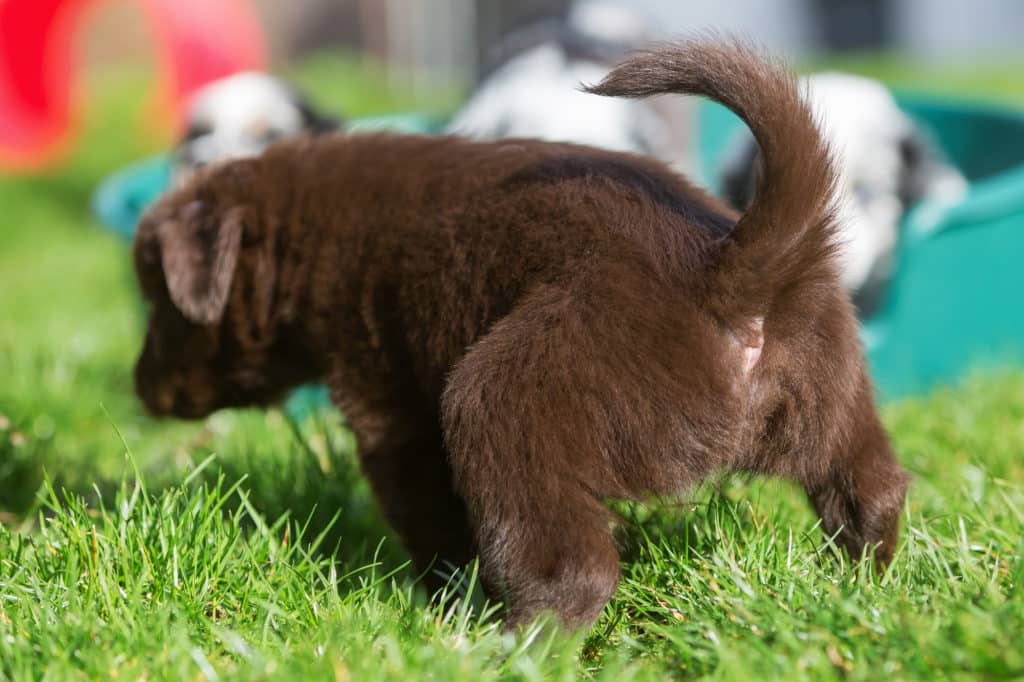Canine cystitis: causes, symptoms and treatment
- Veterinarian Mag.med.vet. Emin Jasarevic
- Updated: 2023-04-13
Your dog has cystitis or you at least suspect it? Then you should read this guide very carefully. I explain everything in detail, from symptoms to possible treatments. In addition, for this article we have Advice from veterinarian Mag.med.vet. Emin Jasarevic obtained. Note: This article is written for the german country.

What is cystitis?
Cystitis is an infection of the urinary bladder. Generally, bacteria, and less frequently viruses or fungi, are responsible. The germs usually enter the bladder from the genital area via the urethra. There they lead to inflammation and irritation of the bladder wall.
Inflammation of the bladder explained in detail (cystitis)
Briefly about my experience: It was early summer and we were with Daisy at the Mediterranean Sea in the vacation home. Times that Daisy likes best.
She romps on the beach, goes swimming: Something that every quadruped wants and does not miss when the opportunity arises.
On such days, of course, she is very active. She has an increased thirst and drinks her water bowl empty several times a day. She also has plenty of water to drink on the beach. There we are well equipped.
However, there was one thing we were not prepared for last early summer:
About a week after our arrival at the cottage, she was not at all cheerful and active as usual. She no longer jumped around and contorted her face when peeing.
That's when I knew something was wrong with her.
As briefly mentioned above, cystitis is the infection of the urinary bladder. It is mostly bacteria and in rare cases viruses, fungi and/or parasites are responsible.
Bladder infections occur mainly in the wet and cold winter season. During long walks and wet fur, the bacteria have a good chance to cause a bladder infection.
In the summertime, swimming too long in cool lakes or the ocean can lead to bladder infections.
The most common trigger is Escherichia coli bacteria. They occur naturally in the intestine and are harmless there. Other pathogens include Proteus mirabilis, staphylococci, streptococci, klebsiae or fungi such as the yeast Candida albicans.
In rare cases, viruses or parasites may be responsible for bladder irritation.
If cystitis occurs more than twice in six months or more than three times in a year, it is chronic. In the case of chronic inflammation, urine samples are examined microscopically and chemically in the laboratory. Apart from this, a urine culture is taken to determine the pathogen more precisely.
Other causes that can lead to cystitis include:
- Urinary stones
- Malposition of the urinary tract
- Narrowing of the urethra
- Diabetes mellitus (diabetes)
- Tumors, polyps
The symptoms
Anyone who has ever had a bladder infection knows the burning pain when urinating. The symptoms in the four-legged friend are about the same. Until the treatment kicks in, it can be very painful.
If your furry friend has the following symptoms, it's time for an appointment with the vet:
The first signs are a increased urination. Although urination takes a long time, only a few drops come out. Some dogs do a slight hump and give sounds of pain of itself.
The odor, color and consistency of the urine change. The urine sometimes contains blood, is cloudy and/or foamy. It smells more severe than usual.
It may happen that your protégé in this phase. is no longer housebrokenbecause he no longer has control over his urination.
If you feel over his belly with your hand, this may cause him pain. The muscles may also be tense.
If the bladder infection is more severe, the kidneys or renal pelvis may be affected. In that case, the symptoms expand to include fever, fatigue, and poor performance.
Which dogs are most affected?
Both female and male dogs can get cystitis at any age.
Bitches are more susceptible. This is because they have a shorter and wider urethra than male dogs. Thus, the pathogens enter the bladder more quickly.
The risk is higher in older dogs or spayed bitches.
Spayed bitches have a lower estrogen level. In addition, their connective tissue slackens more quickly. Therefore, the sphincter of the urinary bladder no longer closes tightly enough. This makes it easier for pathogens to enter the bladder.
Furry noses that suffer from diabetes mellitus (diabetes) are more prone to bladder infections. Too high blood sugar levels cause the sugar to pass through the kidney into the lukewarm urine. This is a good breeding ground for bacteria that create the inflammation. Frequent urination, drinking plenty of water and an appropriate diet can reduce the risk of inflammation.
In male dogs, cystitis often occurs with inflammation of the prostate.
How can I prevent?
You can't avoid cystitis altogether. However, you can reduce the risk.
Especially in cold and wet weather, you should shorten the duration of the walks and walk more often. In addition, your pet should not rest too long on cold damp ground.
In cold weather, the defenses of your faithful companion are weakened. As a result, bacteria & co. can multiply more quickly.
Your hairy friend should not be too soaked in cold weather, because so there is a risk of hypothermia.
Therefore, after a "wet" walk, it is recommended that you dry your pet thoroughly with a towel at home. You can also use a hair dryer on a low heat setting.
If your fosterling has a general tendency to infection, you can give him a Raincoat or winter coat cover. This applies especially for small breed dogs with little undercoat.
Nevertheless, you should not overdo the protection against the cold. Because walks in fresh air also strengthen his immune system.
Make sure that your furry at home does not lie on cold floors such as tiles. For this purpose, an insulating mat or a basket with a blanket inside is sufficient. Note that the place of your favorite is warm, dry and free from drafts.
Basically, the bladder must always be thoroughly flushed. That is why it is important that sufficient water is available at all times and is also drunk.
Your four-legged friend should have the opportunity to "pee" several times a day. Thus, the bacteria do not find the time to multiply in the bladder and are flushed out faster.
A healthy immune system ensures that diseases are prevented as much as possible. Therefore, you should make sure that your dog a balanced or at best organic food gets.
How is cystitis treated?
Treatment of cystitis generally proceeds without complications. This should not be a reason to delay a visit to the vet after a suspicion. Because otherwise the inflammation can spread to the kidneys.
It would be good to take a urine sample from your charge to the vet's appointment.
Your veterinarian will first examine the urine for pathogens. If necessary, he will use further diagnostic methods such as blood, X-ray or ultrasound examinations. In this way, he can either exclude other causes or detect and treat them more quickly.
As a rule, cystitis heals quickly and well.
It is important that you strictly adhere to the time limit of the medication treatment. Even if the symptoms are no longer observed and your protégé feels well again.
In order to flush out the urinary tract during the treatment, your little one should drink plenty of water regularly. If there are difficulties, you can add water to his food.
You can give your pelt nose in addition lukewarm chamomile or fennel tea give. The herbs have a soothing effect on the bladder and urinary tract. your vet will be happy to tell you about the dosage.
Frequently Asked Questions
The typical symptoms are frequent urination. Only a little urine is passed and the dog shows signs of pain. In addition, the urine is very cloudy or foamy, may contain blood and smells more severe than usual.
Fortunately, cystitis in dogs is easily and quickly treated and usually heals well. However, if left untreated, it can lead to complications that could end up being life-threatening.
If you recognize the symptoms of cystitis in your dog, you must take him to the vet immediately. Without medical help, you cannot treat this disease. You can administer chamomile or fennel tea in consultation with the vet.
You can't prevent the risk of bladder infections in dogs, but you can reduce it. Make sure your dog doesn't walk too long or stay wet in cold, wet weather. Also, your dog should not sit or lie on cold surfaces for too long.
Since cystitis in dogs is almost always caused by bacteria, it is contagious to other dogs. Transmission occurs when dogs sniff the urine of infected dogs.
Veterinarian’s Recommendation
Although cystitis is generally relatively quick and easy to treat, you should contact your veterinarian immediately if you suspect it.
Please note: That behind cystitis can be diseases that are serious.
I guarantee you one thing: your dog will look at you with relief at his first painless "pee pee".

I am a veterinarian and writer on animal health topics. Animals are my passion, and it is my personal goal to create medically accurate articles and videos to educate pet owners as much as possible.
Share Now:

